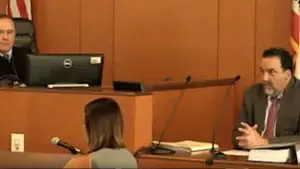

The Expert: Dr. David Patterson, a California-based physiatrist, details his exam of the plaintiff as well as his diagnosis of her injuries.

Testifying in a 2018 California trial as a physical medicine and rehabilitation specialist, or physiatrist, Dr. David Patterson, from Pomona, California, gives his opinion on injuries a plaintiff suffered in a fall from a wheelchair lift that had been installed on her staircase.
The doctor first outlines the difference between sensory perception and pain perception, relating the latter to phantom pain due to pain feedback loops that remain intact despite loss of a limb or other sensations. In this case, the patient perceived the skin of her hands to be like sandpaper, yet the pain in her hands was significant.
He reports that his examination of the plaintiff revealed atrophy and contractures of her hands and arms. He adds that, based upon reasonable medical probability, this was the result of the injury from the wheelchair lift. He further reports that the plaintiff also had “hammer toe deformity” of her feet, which she did not previously have, as well as significant limitation of the range of motion in her neck. This was consistent with the neck fusion that had been performed. The left rotator cuff tear she suffered had resulted in limited range of motion of the left shoulder. Although the doctor concurs that this was likely there before this more recent event, he feels that this situation was significantly aggravated by the trauma, as well as the rehabilitation process.
The functional problems that this patient has had with her shoulders after the fall, the doctor says, compounds the problems that she has with her arms and hands by forcing the shoulders to become weight bearing. This makes activities of daily living more difficult. Because this patient was ruled out as a surgical candidate, her limited range of motion in shoulders, arms, and hands are a lifelong disability.
Additionally, dysphagia, or difficulty in swallowing is a problem for this plaintiff, the expert explains, and confirming that this is related to her neck surgery. This condition has led to coughing and choking.
When questioned about the patient’s ability to transfer from one surface to another, the doctor explains that there are different types of transfers. Use of a Hoyer Lift is the most dependent type of transfer, requiring a device that acts like a “cherry picker lift” to carry the patient from bed to wheelchair, for example. A slideboard transfer is the next most dependent, where a board is placed between supporting surfaces and the patient slides across on it.
In this case, the patient is able to perform a standing pivot transfer with assistance, where if she is lifted with a gait belt to a standing position, she can twist herself so that she can be guided by a caretaker to sit on her wheelchair. Although this indicates that there is some muscle function in her legs, this function is obviously limited. Patterson testifies that, even though the plaintiff used this technique occasionally prior to her fall, she has become dependent upon it now.
The physiatrist then describes the appearance and physiology behind the “claw deformity” of this patient’s hands. Dupuytren’s contracture occurs when the flexor tendons lose their ability to function and become “hard fibrous cords” that pull the digits into permanent flexion. He says this is most common in the second and third digits.
In patients with brain injury, stroke, or spinal cord injury, spasticity may develop. The rehabilitation expert explains that spasticity is not a cramp or spasm, but a well-defined, velocity-dependent phenomenon causing resistance to movement. This can be quantitated by a scale, and in this case the patient has “excessive spasticity”. This is not the worst on the scale, however, as a full contracture would be at the top of the spasticity scale. If the spasticity has not resulted in full contracture, the expert explains, it is treatable with Baclofen medication or Botox injections. These paralyze or weaken the spastic musculature to allow the opposing muscle groups to be strengthened so they can straighten a spastic limb. Patterson believes the patient had spasticity prior to the fall from her lift, but that it has worsened significantly since.
As evidence for this, he discusses the patient’s new requirement for intrathecal Baclofen. Lower degrees of spasticity can generally be treated by oral Baclofen, which this patient had taken prior to the accident. The dose can be increased, but absorption and transfer into the cerebrospinal fluid, where the nerve receptors are, can be erratic and ineffectual in severe cases. In those cases a pump can be implanted beneath the skin with a catheter tunneled into the cerebrospinal spinal fluid to get the Baclofen directly where it needs to go to be most effective.
In this particular case, the worsening spasticity became a hindrance to this patient’s mobility when she was on oral Baclofen, so she required the use of a Baclofen pump.
The expert’s opinion helped deliver a $1.19 million verdict.
Gary Gansar, MD, is residency-trained in general surgery. He served as Chief of Surgery and Staff at Elmwood Medical Center and on the Medical Executive Committee at Touro Infirmary and Mercy Hospital in New Orleans, LA. Dr. Gansar was Board Certified in general surgery while in active practice. He joined AMFS in 2015 as a Physician Medical Director.
The medical expert witness partner for attorneys serious about building a winning case
AMFS is your trusted source for highly-qualified medical expert witnesses. After pioneering the field nearly three decades ago, we’re continuing to redefine medical expert witness services by providing value far beyond a referral alone.
Our Physician Medical Directors know what it takes to build a strong case. Our medical expert witnesses leave no doubt. And our case managers streamline billing and logistics every step of the way, letting you focus on what you do best: constructing your winning case. Explore why AMFS clients expect more from their medical expert witnesses—and get it.
